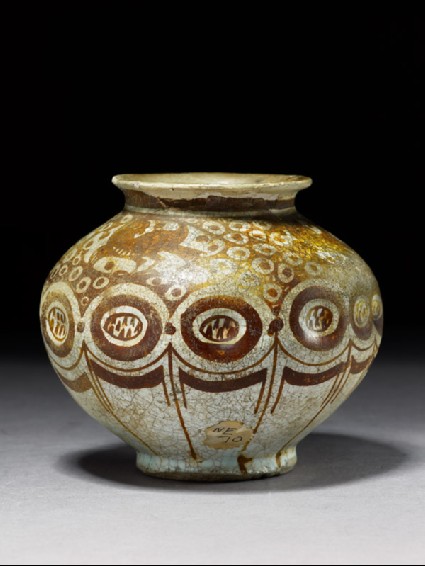Browse: 80 objects
- Reference URL
Actions
Jar with birds
-
Description
First seen in ninth-century Iraq, lustreware became popular in Fatimid Egypt (AD 969-1171), the period to which this jar can be attributed. Unlike lands to the east, Egyptian lustreware included naturalistic designs in its decorative repetoir. Animals, real or composite, and birds, were popular motifs, and were often executed with remakable spontaneity. Some of the most sophisticated examples of lustreware were also decorated with fine human representations, including Christian subjects, suggesting a broad market for this type of luxurious ceramics.
-
Details
- Associated place
- Date
- 11th century (1001 - 1100)
- Material and technique
- earthenware, with painting in lustre over an opaque white glaze
- Dimensions
-
10.5 cm (height)
12.5 cm (diameter)
- Material index
- Technique index
- Object type index
- No. of items
- 1
- Credit line
- Gift of Gerald Reitlinger, 1978.
- Accession no.
- EA1978.2248
Glossary (3)
earthenware, glaze, lustre
-
earthenware
Ceramic material made of clay which is fired to a temperature of c.1000-1200⁰c. The resulting ceramic is non-vitreous and varies in colour from dark red to yellow.
-
glaze
Vitreous coating applied to the surface of a ceramic to make it impermeable or for decorative effect.
-
lustre
Metallic sheen obtained by applying a mixture of metallic oxides onto an already glazed ceramic that is refired at a reduced atmosphere.
Location
-
- currently in research collection
Objects are sometimes moved to a different location. Our object location data is usually updated on a monthly basis. Contact the Jameel Study Centre if you are planning to visit the museum to see a particular object on display, or would like to arrange an appointment to see an object in our reserve collections.
© 2013 University of Oxford - Ashmolean Museum

